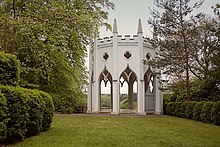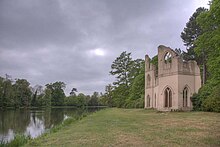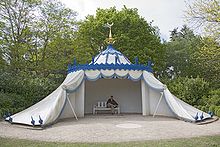Painshill Park
Painshill Park is a historic garden near Cobham ( Surrey , England ). Charles Hamilton designed it in the period from 1738 to 1773. It was one of the first systems in the style of the English landscape gardens . It became the model for numerous parks in Europe. After Hamilton's death, the garden was neglected and partially abandoned. In 1980 the Painshill Park Trust began restoration work.
history
The creation of Painshill Park is closely linked to the life story of Charles Hamilton. He had traveled to Italy in 1732, visited Rome and acquired numerous paintings and ancient sculptures there. From 1738 he began to put his artistry and love for antiquity into practice with the design of a contemporary, new type of garden, the landscape garden. On a site of fifty and later eighty hectares - leased and enlarged through acquisitions - consisting of heather and woodland, a picturesque park landscape gradually emerged. Hamilton developed from a horticultural amateur to a skilful and resourceful landscape architect, to whom the experts of his time praised and recognized. His project was financed by extensive debt: one of his financiers was the banker Henry Hoare the Elder. J. , who later created a famous landscape park with Stourhead .
The elongated property (around 1.5 kilometers) was completely changed by creating an artificial lake. The water was pumped from the south-running Mole by means of a bucket wheel . The construction of bridges that connected the islands and numerous garden accessories brought Hamilton into financial difficulties, which could not be resolved even with the income of a hastily erected tile factory. Hamilton, also plagued by health problems, was therefore forced to sell the entire property in 1773.
The park fell to neglect under the subsequent owners. In 1948 parts were sold for agricultural and forestry use. Due to public pressure in the 1970s, Elmbridge Borrough Council acquired about 65 acres of the property and in 1980 initiated the creation of the Painshill Park Trust , which has since been dedicated to restoring the garden.
Shape and equipment
The artificial lake (around 1760), covering around eight hectares, forms the central area of the gardens. With great empathy, Hamilton inserted various landscape productions into the slightly undulating landscape that surrounds him; picturesque scenes were created with very different moods. For example, there were scenes borrowed from antiquity with a Temple of Bacchus ("Temple of Bacchus ", with the assistance of Robert Adams) in a colorful setting, whereas a Roman mausoleum in a rough and dreary landscape. A rustic hermitage (destroyed), which was located in a gloomy forest area, corresponded to yet another emotional situation . The hermitage was reconstructed in 2004 based on historical drawings; a decorative hermitage once served as a picturesque sight.
The numerous garden buildings and follies included a pavilion and a tower, both in neo-Gothic style . The tower (before 1760) served as a lookout point. A “Turkish tent” corresponded to the contemporary taste for exoticism (1772, attributed to Henry Keene, restored somewhat offset). On the shores of the lake there was an artificial ruin that represented an abbey (around 1770, restored). Hamilton achieved an extravagant masterpiece with the creation of a grotto (1765, by Joseph Lane), which he had built on the corner of an island. Its interior was designed like a cave and, apart from the main room, had waterfalls and side rooms. The walls were covered with mineral crystals, which glitteringly reflected the daylight falling from the surface of the lake (heavily damaged, restored).
Painshill Park's planting included a large number of foreign plants as well as conifers from North America. The plants underlined the picturesque character of the garden.
Garden history classification
Already contemporary visitors (including Horace Walpole , William Gilpin , Thomas Whately and Thomas Jefferson ) were inspired by Painshill Park. Hamilton's creation, along with Stowe House and Stourhead, is one of the prototypes of the English landscape garden. The illusion-rich landscape sections became the model for numerous later gardens, for example in Ermenonville and Wörlitz .
Hamilton advised, among others, Henry Hoare the Elder. J., Henry Fox (Holland Park) and probably William Beckford ( Fonthill Abbey ). His ideas had a decisive influence on the development of the "free" English garden style, which was modeled on nature and continues to have an impact today. Hamilton's mastery of expressing feelings and moods in a harmonious landscape staging was seldom achieved again.
literature
sorted alphabetically by author
- Gwyn Headley, Wim Meulenkamp: Follies, grottoes, and garden buildings. Aurum Press, London 1999, ISBN 1-85410-625-2 , pp. 488-490.
- Mark Laird: Reconstruction, Monument Preservation and Conservation in Painshill Park: Reconciliation between art and nature . In: Die Gartenkunst 9 (2/1997), pp. 274–283.
- Michael Symes: Painshill . In: Patrick Goode, Michael Lancaster (Eds.): The Oxford companion to gardens. Oxford, New York 2001. ISBN 0-19-860440-8 , pp. 417-418.
- Michael Symes: Painshill Park . In: Jane Turner (Ed.): The dirctionary of art. Volume 23. London 1996. ISBN 1-884446-00-0 , p. 782.
Web links
Coordinates: 51 ° 19 ′ 43.9 " N , 0 ° 25 ′ 46.48" W.


